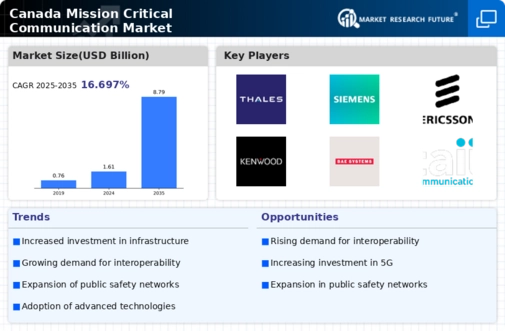Regulatory Compliance and Standards
The mission critical-communication market in Canada is increasingly influenced by stringent regulatory compliance and standards set by government bodies. These regulations ensure that communication systems meet specific safety and reliability criteria, particularly for emergency services. The Canadian government has established frameworks that mandate the use of interoperable communication systems among various agencies. This compliance not only enhances operational efficiency but also fosters public trust in emergency response capabilities. As a result, organizations are compelled to invest in advanced communication technologies that align with these regulations, thereby driving growth in the mission critical-communication market. The market is projected to expand as agencies prioritize adherence to these standards, which could lead to an increase in market value by approximately 15% over the next five years.
Public Safety Initiatives and Funding
Public safety initiatives significantly impact the mission critical-communication market in Canada. Government funding aimed at enhancing public safety infrastructure has led to increased investments in communication technologies. Programs designed to improve emergency response capabilities often allocate substantial budgets for upgrading communication systems. For instance, recent funding announcements have earmarked millions of dollars for the modernization of communication networks used by police, fire, and medical services. This influx of capital is expected to drive innovation and adoption of advanced communication solutions, thereby expanding the mission critical-communication market. Analysts suggest that this trend could result in a market growth rate of approximately 12% over the next five years as agencies leverage new technologies to improve public safety outcomes.
Growing Focus on Cybersecurity Measures
As the mission critical-communication market in Canada evolves, the growing focus on cybersecurity measures emerges as a crucial driver. With the increasing reliance on digital communication systems, the potential for cyber threats poses significant risks to public safety operations. Agencies are recognizing the necessity of implementing robust cybersecurity protocols to protect sensitive information and ensure the integrity of communication networks. This heightened awareness is prompting investments in advanced security technologies, which are essential for safeguarding mission critical communications. The market is likely to see a surge in demand for cybersecurity solutions, with estimates suggesting a growth of around 18% in this segment over the next few years. This trend underscores the importance of securing communication infrastructures against evolving cyber threats.
Technological Advancements in Communication
Technological advancements play a pivotal role in shaping the mission critical-communication market in Canada. Innovations such as 5G networks, artificial intelligence, and enhanced data analytics are revolutionizing how emergency services communicate. These technologies enable faster response times and more reliable communication channels, which are essential during critical incidents. The integration of AI-driven analytics allows for real-time data processing, improving situational awareness for first responders. As these technologies continue to evolve, they are expected to drive significant investments in the mission critical-communication market, with estimates suggesting a potential growth of 20% in the next few years. This trend indicates a shift towards more sophisticated communication solutions that can adapt to the dynamic needs of emergency services.
Increased Demand for Interoperability Solutions
The demand for interoperability solutions is a key driver in the mission critical-communication market in Canada. As various agencies and organizations strive to enhance collaboration during emergencies, the need for systems that can seamlessly communicate across different platforms becomes paramount. This demand is particularly evident in urban areas where multiple agencies may respond to incidents simultaneously. The Canadian government has recognized this need and is actively promoting initiatives that encourage the development of interoperable communication systems. Consequently, this focus on interoperability is likely to stimulate growth in the mission critical-communication market, with projections indicating a potential increase in market size by 10% over the next few years as agencies invest in compatible technologies.






















Leave a Comment